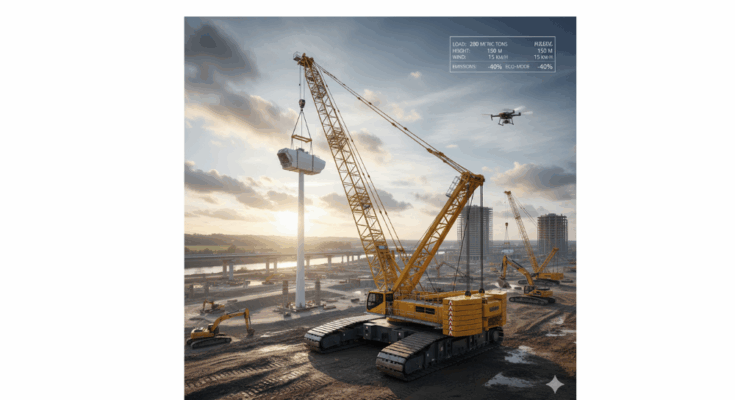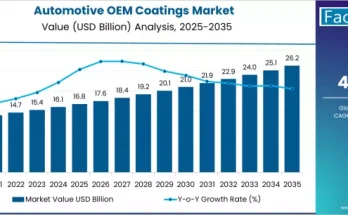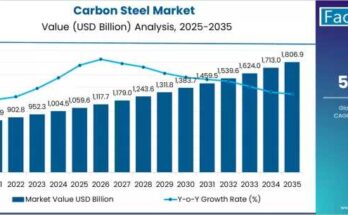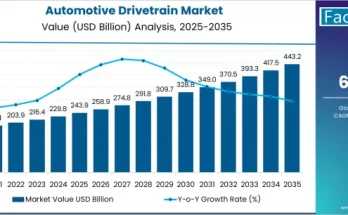The global crawler cranes market is poised for steady expansion, projected to increase from USD 5.2 billion in 2025 to USD 8.2 billion by 2035, according to the latest research by Fact.MR, a market intelligence firm. The market is expected to register a compound annual growth rate (CAGR) of 4.6% between 2025 and 2035, driven by the accelerating pace of infrastructure development, industrialization, and the global shift toward renewable energy.
Crawler cranes, known for their superior lifting capacity, stability, and performance on uneven terrain, are vital for heavy-duty construction and energy projects. Their ability to operate efficiently in challenging environments has made them indispensable for large-scale developments in transportation, oil and gas, power generation, and offshore wind energy.
Infrastructure Boom and Energy Transition Fuel Market Momentum
The growing global demand for robust infrastructure is one of the primary growth drivers of the crawler cranes market. Emerging economies, particularly in Asia Pacific and the Middle East, are witnessing unprecedented investment in roads, bridges, ports, and urban infrastructure, increasing the need for reliable heavy-lifting equipment.
Crawler cranes play a crucial role in these projects—lifting precast structures, bridge sections, and turbine components—making them essential for contractors focused on speed, safety, and precision. The energy sector is another major growth avenue, where crawler cranes are heavily utilized in wind turbine installations, oil rigs, and refinery construction.
“The energy transition and infrastructure modernization trends are reinforcing global crawler crane demand,” said a Fact.MR analyst. “The shift toward renewable power generation, especially wind and solar, is opening new opportunities for manufacturers offering high-capacity, eco-friendly, and digitally enhanced crane solutions.”
Technological Advancements Redefine the Industry
Innovation is rapidly transforming the crawler crane landscape. The integration of telematics, automation, hybrid powertrains, and modular designs is improving operational efficiency and sustainability. Telematics and IoT-enabled monitoring systems allow operators to track performance, detect maintenance needs, and optimize fuel use in real time—reducing downtime and improving safety on job sites.
Manufacturers are also prioritizing modular crane architectures for easier transportation and faster assembly, meeting the evolving logistical demands of mega projects. Furthermore, the rise of hybrid and electric crawler cranes—such as Liebherr’s LR 1300.2 SX unplugged—is addressing environmental concerns while maintaining high power and performance levels.
Leading companies including Liebherr Group, Manitowoc Company, Kobelco Construction Machinery, Hitachi Sumitomo Heavy Industries, XCMG, Zoomlion, SANY, and Terex Corporation are investing in R&D to deliver next-generation cranes that combine sustainability, intelligence, and strength.
Regional Outlook: Asia Pacific Dominates, North America and Europe Gain Momentum
Asia Pacific Leads Global Demand
Asia Pacific remains the largest regional market, accounting for a significant share of global crawler crane sales. Countries such as China, India, and Southeast Asian nations are spearheading growth through large-scale public infrastructure projects, renewable energy installations, and industrial expansion.
China’s Belt and Road Initiative (BRI) continues to create opportunities for construction equipment suppliers, while India’s Bharatmala, Sagarmala, and Smart Cities Mission programs are fueling domestic demand for heavy lifting solutions. The increasing number of offshore wind projects across Asia further strengthens the region’s position as a global demand hub.
North America: Infrastructure Renewal and Green Energy Drive Adoption
In North America, particularly the United States, demand remains robust due to infrastructure renewal, wind power expansion, and energy system upgrades. Federal initiatives such as the Infrastructure Investment and Jobs Act have triggered a wave of heavy construction activity across bridges, highways, and water systems.
U.S. manufacturers including Manitowoc and Link-Belt are leveraging this demand surge by introducing fuel-efficient, digitally monitored, and hybrid crawler cranes tailored for green energy applications. The ongoing shift toward low-emission and hybrid machinery aligns with America’s decarbonization goals, presenting lucrative opportunities for sustainable equipment manufacturers.
Europe: Sustainability and Advanced Manufacturing at the Core
Europe’s crawler crane market benefits from the continent’s focus on renewable energy and environmental regulations. Countries such as Germany, the U.K., and France are rapidly expanding offshore wind capacities, demanding cranes capable of lifting tall turbine towers and massive nacelles. European manufacturers are responding with cranes that feature enhanced telematics, automation, and safety systems, ensuring compliance with stringent EU standards.
Capacity and Application Trends
Crawler cranes with 151–300 tons lifting capacity currently dominate global demand due to their versatility and suitability for infrastructure and energy applications. Meanwhile, cranes above 300 tons represent the fastest-growing category, driven by offshore wind installations and large-scale industrial projects.
From an application perspective, infrastructure construction remains the leading segment, followed by energy and industrial sectors. Massive investments in transportation networks and renewable energy infrastructure worldwide are expected to sustain strong demand throughout the next decade.
End-Use Dynamics: Contractors and Rental Firms Lead Adoption
Construction contractors represent the largest end-user base for crawler cranes, primarily due to long-term project engagements requiring reliable, high-capacity lifting solutions. However, the rental segment is expanding rapidly, driven by growing demand for flexible, cost-efficient crane access across short-term and specialized projects.
As crawler cranes remain capital-intensive, rental service providers are emerging as key intermediaries—offering technologically advanced fleets and influencing product design preferences toward modularity, quick setup, and lower emissions.
Competitive Landscape and Future Outlook
The crawler cranes market is witnessing heightened competition as manufacturers focus on strategic partnerships, digital integration, and sustainable engineering. Innovations such as real-time telematics monitoring, predictive maintenance, and AI-based operational analytics are helping firms differentiate their offerings and improve project efficiency.
Fact.MR anticipates that manufacturers embracing automation, green technology, and modular design principles will gain a competitive edge in the coming decade. The combination of infrastructure investment, renewable energy growth, and industrial modernization is expected to propel the crawler cranes industry into a new era of intelligent, sustainable heavy lifting.
Browse Full Report : https://www.factmr.com/report/2236/crawler-cranes-market



